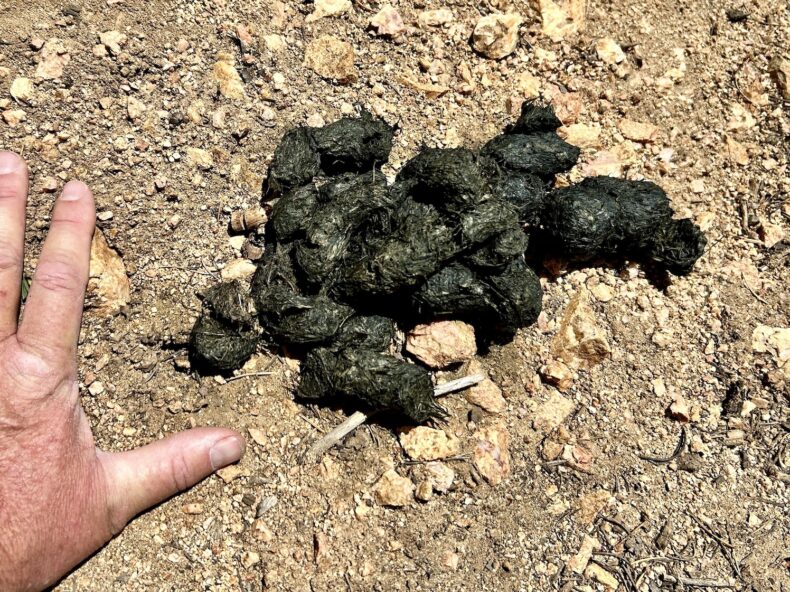
A coyote urine mark I investigated with my nostrils in the snow was lemony and oceanic with an aftertaste of burning sulfur and fetid saltwater.
A healthy piss from a black bear in the sand I’d call oak barrel stank. I got my nose as close as I dared into the stained hole from the gush of a bear squat and I winced, taking in a full breath of meaty, dark acid, like the bear had been holding it in for a while.
Urine smell often worsens over time because it concentrates sulfur-containing compounds called mercaptans, which are also found in skunk spray. They smell like ammonia and garlic, and in excessive, industrial amounts where the compound is used as an oderant, it can cause organ failure, which is why it’s so offensive to us. In smaller amounts, you’ll be fine.
As a tracker, I’d call myself a hobbyist. I’ve followed avid trackers to see where they look. Places where animals have scraped or pissed or pooped are of great interest. In my youth, a field biologist I knew came back from studies in Central African jungles and urged me to explore animals by getting my nose in there. I remember both of us crouched at the same warm pile of fresh coyote scat in the Sonoran Desert. The coyote had been eating honey mesquite seeds, giving the scat the smell of a warm, sweet oatmeal.
My purpose in doing any of this is to fill in blanks on wild animals. I’ve written for LWON in the past about poop sending signals. I identify species and note them in a journal. Nobody reads this journal, it’s only for my elucidation. Like I said, I’m a hobbyist.
With urine marks I’ll inhale liberally because there’s more information than from poop. Urine is meant to be smelled. It’s why dogs piss on fire hydrants. Sniffing poop is unseemly, less than hygienic, so I wouldn’t take more than two or three quick sniffs. In fact, I wouldn’t sniff feces at all if I were you. What good could come of it?
Poo smell is not without its particulars. Many mammals and reptiles have anal glands that when squeezed by the outgoing log lets out what is often an oily, brownish fluid with a strong, rotten, fishy, or metallic odor. This additive carries cues about the animal’s sex, reproductive state, and identity.
I don’t bother with rodents, too much danger of illness, and rat shit would hardly be nuanced to my nose. I’ll mask up when sweeping out the shed. Domestic dog or cat are strictly avoided. Just, ew. Fresh cow poop, no way. Why would you even think of that?
Carnivore poop is the worst. It’s rare that I’ll do anything but poke it with a stick to see what the animal has been eating. Under the right conditions, I might lean in. A fox poop when the animal is gorging on red Rhus trilobata seeds in the rain has kind of a fermented cranberry scent.
The meat poops, black predator droppings, I try to stay away from. They just stink. I found a dark, fresh fox poop on the trail the other day, and it’s been a few years since I’ve had a sniff of anything fox so I put my nose down close, took two quick sniffs for safety, then a third that was half a second longer to get the point.
Another fox would smell estrus or body fitness, a bouquet of data. You’d know more taking a whiff than if you saw this fox face to face. That’s why you often find scat dropped in the middle of the trail. It’s a scent post. Even deer leaning down would know a thing or two about this animal. My nose is simple and all I can offer is that, as I expected, this fresh fox poop stank.
Fascinating, and I say that in all honesty. I often find scat on my rural country hikes and can only make guesses as to who they belong to, except coyote, coyote is quite obvious.
I thought I was doing well to identify one scat from another. Lots of practice when we lived in Truckee. Never in my wildest dreams, though, did I ever think that kneeling down to sniff poop was really A Thing.
Baby Bear!!